If you would prefer to download this document
as a pdf file, Click Here.
LIST
OF TABLES AND CHARTS
ECONOMIC
OUTLOOK
Alberta turned in another strong economic performance in 2001, growing by an estimated 4.5%. Strong growth in household spending, spurred on by tax cuts and a healthy labour market, helped insulate the Alberta economy from declining energy prices and the U.S. recession.
Lower energy prices are expected to reduce business investment in 2002 and limit Alberta's economic growth to 2.5%. Economic growth is expected to rebound to 3.9% in 2003 as the recovery strengthens in the United States and Canada. Alberta's economic growth is expected to average a healthy 3.6% per year over the medium term.
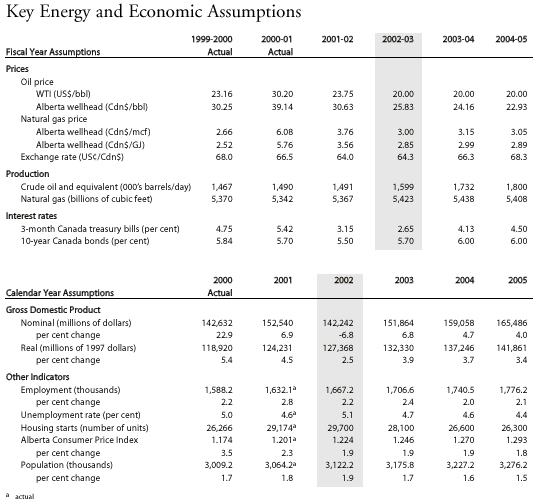

2001 IN REVIEW
Despite the North American slowdown and weakening energy prices, the Alberta economy grew by an estimated 4.5% in 2001. Although overall activity in the conventional energy sector slackened as prices weakened through the year, a 43% increase in oil sands investment helped boost energy investment by 23%. Household spending remained strong throughout the year due to a healthy labour market and large personal income tax cuts.
-
In January 2001, tight energy supplies and cold weather in the United States brought high energy prices and fears of emerging shortages. Alberta's natural gas reference price peaked at Cdn$11.82 per thousand cubic feet (mcf), while West Texas Intermediate oil prices averaged US$28.68 per barrel. Activity in Alberta's energy sector surged in the first quarter – rigs drilling reached the highest level in more than 10 years and the value of natural gas exports to the United States was up 230% from the preceding year.
-
In March 2001, the U.S. economic slowdown turned into a recession. The fall in demand resolved the U.S. energy problem, natural gas prices began to slide and OPEC cut production in an effort to maintain oil prices.
-
OPEC's efforts were relatively successful until the fallout from the September 11 terrorist attacks exacerbated the existing economic weakness. By December 2001, the price of West Texas Intermediate had fallen to US$19.36 per barrel and the Alberta natural gas reference price was Cdn$3.37 per
mcf.
-
Drilling activity came down sharply in the fall of 2001, leaving the number of rigs drilling up only 0.7% for the year as a whole. A 43% increase in oil sands investment, however, boosted overall investment in the energy sector by 23%.
-
The value of international goods exports also weakened in the latter part of 2001, but was up 3.0% for 2001 as a whole. Manufacturing shipments were down 0.3% in 2001.
-
Alberta's livestock sector performed well in 2001. Livestock receipts rose 16.6% to a record $5.2 billion due to record receipts for both hogs and cattle. Drought in much of the province, however, limited the increase in crop receipts to 0.7%. Direct program payments increased by 18% to $836 million. Overall farm cash receipts hit a record $8.3 billion.
-
Although the pace of job growth moderated slightly towards the end of the year, the Alberta economy created 43,900 new jobs in 2001. The average unemployment rate fell to 4.6%, the lowest in Canada and the lowest annual level in Alberta since 1981. Job gains were led by mining, construction, and professional, scientific and technical services.
-
Alberta's strong economy and low taxes attracted 21,154 net interprovincial migrants to the province in the first three quarters of 2001, mostly from British Columbia, Saskatchewan and Ontario. Alberta's population reached 3,064,249 on July 1, 2001, up 1.8% from 2000.
-
With a $1.1 billion cut to provincial personal income taxes, personal disposable income increased by an estimated 8.0% in 2001. Retail sales were up 9.1% in 2001, the fastest growth in Canada. Falling interest rates gave an extra boost to housing starts, which were up by 11.1%.
-
Falling energy prices reduced the overall CPI inflation rate to 2.3% in 2001, down from 3.5% in 2000.
GLOBAL ECONOMIC OUTLOOK
After 10 years of expansion, the U.S. economy officially entered a recession in March 2001, triggered by a sharp decline in business investment, particularly in high technology. Unlike past recessions, consumer spending remained healthy and helped moderate the decline. U.S. authorities reacted vigorously. The Federal Reserve cut U.S. interest rates by 4.75 percentage points, and the Bush administration cut taxes by over $100 billion. Even so, U.S. economic growth fell from 4.1% in 2000 to 1.2% in 2001.
The U.S. slowdown dragged down global economic growth. Economic growth in Canada dropped from 4.4% in 2000 to an estimated 1.5% in 2001 despite major federal and provincial tax cuts and a 3.75 percentage point cut in interest rates. Growth in Europe slowed from 3.4% in 2000 to an estimated 1.4% in 2001 and Japan entered a deep recession.
Recent indicators suggest that the U.S. economy is beginning to stabilize. The economy managed to eke out a small gain at the end of 2001 and the pace of job losses has slowed. U.S. economic growth should strengthen over the course of this year, although growth for 2002 is expected to average only 2.0%. The U.S. economy is expected to pick up in 2003 with growth of 3.6%. The Canadian economy is expected to follow the U.S. recovery as growth is expected to average 2.0% in 2002, and then pick up strongly to 3.5% in 2003.
World oil prices are expected to fluctuate around US$20 per barrel over the 2002-03 to 2004-05 period. Alberta natural gas prices are expected to average $3.00 per mcf in 2002-03, $3.15 per mcf in 2003-04 and $3.05 per mcf in 2004-05.
ALBERTA ECONOMIC OUTLOOK
Alberta's real economic growth is expected to slow to 2.5% in 2002. Although consumer spending should remain strong, investment is expected to fall. Activity in the conventional energy sector has already weakened in response to lower prices (especially for natural gas), and while investment in oil sands is expected to remain high, it is not expected to grow. Investment in the non-energy sector is expected to remain weak until the North American recovery takes hold and corporate profits improve. Exports are expected to post fairly healthy growth this year as production from oil sands expansions comes on stream. Despite the rise in real gross domestic product (GDP), Alberta's nominal GDP is expected to decline by 6.8% because of the sharp fall in oil and natural gas prices from their peak in the first quarter of 2001.
Alberta's real economic growth is expected to rebound to 3.9% in 2003 as the recovery takes hold in the rest of North America. Over the medium term, real economic growth is expected to moderate to a more sustainable average of 3.6%. Employment growth is forecast to average 2.2% over the 2002 to 2005 period, and the unemployment rate is expected to edge down to 4.4% by 2005.
RISKS
Although the U.S. economy is showing encouraging signs of recovery, the possibility of a double-dip recession remains a key risk. The gain in the fourth quarter of 2001 was concentrated in government spending and incentive-induced auto sales. A sustained recovery is unlikely without a revival in corporate profitability and business investment. A renewed outbreak of terrorism could also weaken the economic outlook in the United States and the rest of the world.
Failure by OPEC and other key producing states like Russia to adhere to production cuts could lead to further weakness in oil prices. Natural gas prices are also dependent on the U.S. recovery, especially in view of increased supplies over the past few years.


global
slowdown in 2001
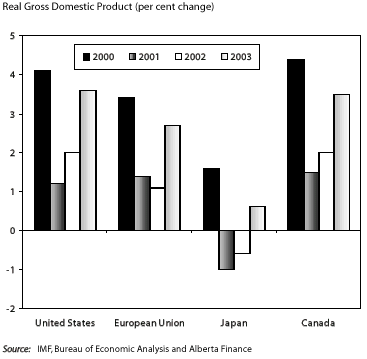
-
The U.S. economy entered a recession in March 2001. Economic growth slowed from 4.1% in 2000 to 1.2% in 2001, triggering a synchronized global slowdown. In Canada, economic growth slowed from 4.4% in 2000 to 1.5% in 2001.
-
Recent indicators suggest that the U.S. economy is beginning to respond to the aggressive cuts in interest rates and taxes over the last year. In 2002, growth is expected to average 2.0%, increasing to 3.6% in 2003.
-
Canada is expected to follow the United States, posting growth of 2.0% in 2002 and 3.5% in 2003.

more
moderate oil prices

-
The global slowdown in 2001 weakened the demand for oil. Oil prices remained relatively high for most of the year due to a coordinated effort by OPEC.
-
World oil prices dropped from around US$27 per barrel to around US$23 per barrel in late September. Since then, they have averaged just over US$20 per barrel. OPEC succeeded in convincing other major producers like Russia and Norway to cut production in concert with OPEC members, averting a steeper decline in prices.
-
Oil prices for 2001-02 are now expected to average US$23.75. Over the 2002-03 to 2004-05 period, oil prices are expected to average US$20 per barrel.

natural
gas prices MODERATE
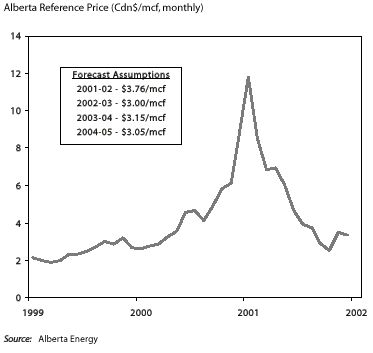
-
Natural gas demand has been hard hit by the U.S. recession. Output in the U.S. industrial sector, which accounts for almost half of the natural gas consumed in the United States, has been declining since June 2000. Increased supplies of natural gas and warm weather this winter have further weakened natural gas prices.
-
Natural gas prices are now expected to average $3.76 per thousand cubic feet (mcf) in 2001-02, $3.00 per mcf in 2002-03, $3.15 per mcf in 2003-04 and $3.05 per mcf in 2004-05.

CANADIAN
inflation coming down
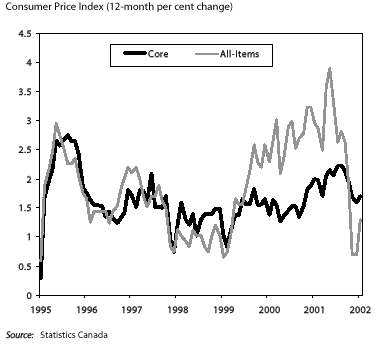
-
Over the past two years, rising energy prices pushed up the overall Consumer Price Index (CPI) inflation rate, although underlying inflation pressures remained subdued in both Canada and Alberta. For Canada, the all-items inflation rate was 2.5% in 2001, while core inflation was 2.0%.
-
Overall inflation in Alberta was 3.5% in 2000, retreating to 2.3% in 2001 even though the core CPI inflation rate, which excludes food and energy, remained stable at around 2% for both years.
-
Over the medium term, the overall inflation rate for both Alberta and Canada is expected to be around 2%, the mid-point of the Bank of Canada's 1% to 3% inflation target zone.

lowest
interest rates in decades
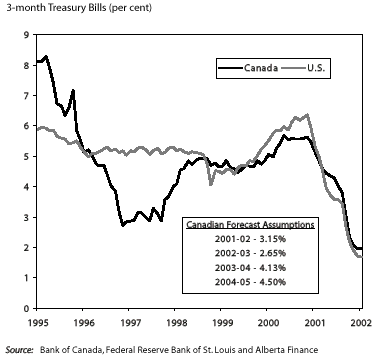
-
The U.S. Federal Reserve reacted strongly to the weakness in the U.S. economy, cutting interest rates by 4.75 percentage points in 2001, and bringing short-term rates to their lowest levels in 40 years.
-
The Bank of Canada has cut interest rates by 3.75 percentage points since January 2001. The cuts were smaller than in the United States since federal and provincial tax cuts at the beginning of 2001 helped to maintain economic growth early in the year. As well, the Canadian dollar weakened, falling from US66.8 cents at the beginning of 2001 to an all-time low of US62.0 cents in January 2002.
-
Over the medium term, interest rates are expected to increase as the Canadian and U.S. economies strengthen.

alberta
outperforms
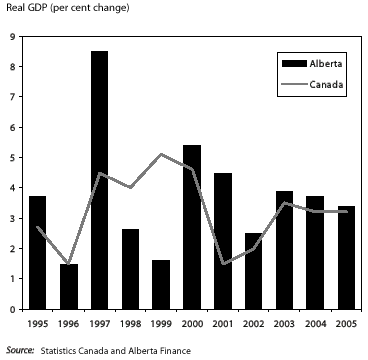
-
Alberta outperformed the Canadian economy in 2001, growing at an estimated 4.5%, compared to 1.5% nationally. Strong consumer spending and high energy sector investment helped shield Alberta from the downturn in the rest of North America.
-
Although Alberta’s economic growth is forecast to slow to 2.5% in 2002 as investment falls, Alberta is expected to continue outperforming the Canadian economy. The strong rebound in U.S. economic activity in 2003 is expected to provide a strong boost to economic activity in both Canada and Alberta.

business
investment to fall in 2002

-
Conventional energy sector investment weakened over the course of 2001 as energy prices fell. Drilling activity was up 11.9% in the first 9 months of 2001, compared to the same period in 2000. It dropped in the autumn as prices weakened, leaving the number of rigs drilling up 0.7% for 2001 as a whole. In 2002, real energy investment is expected to fall 10%, reflecting lower oil and natural gas prices.
-
Non-energy investment is also expected to weaken in 2002, due to a weaker external environment. It is expected to pick up as the North American economy rebounds and corporate profits recover.

oil
sands up strongly in 2001

-
The main increase in business investment in 2001 was in oil sands, which represents approximately 30% of Alberta's total energy investment. Oil sands investment has increased dramatically over the last few years, rising from just under $1 billion in 1995 to almost $6 billion in 2001. Oil sands investment was up 43% in 2001.
-
In 2002, oil sands investment is expected to increase 1.6% according to Statistics Canada’s investment survey. It is thus expected to remain high, but not to show the same kind of growth as it has in recent years.

non-conventional
oil still growing

-
Over the medium term, oil sands are expected to lead total oil production in Alberta.
-
There are about $17 billion worth of oil sands investment projects announced for the next 10 years, and an additional $30 billion in the proposal stage. Consequently, non-conventional oil production is expected to increase by more than two-thirds by 2005. It should account for about two-thirds of Alberta's oil production in 2005, compared to 44% in 2000.

alberta
exports driving growth
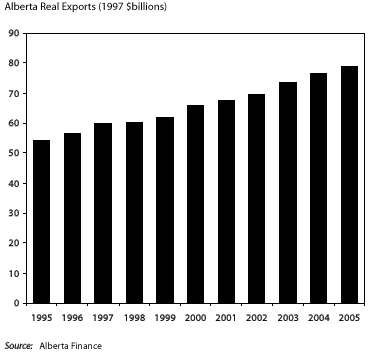
-
Large increases in non-conventional oil production are expected to provide a boost to Alberta's energy exports over the forecast horizon.
-
Non-energy exports are also expected to rebound as the North American economy strengthens in 2003.

farm
cash receipts up

-
Despite some regional problems, Alberta's farm cash receipts were a record $8.3 billion in 2001.
-
Most of the increase was due to livestock receipts, which rose by 16.6% to a record $5.2 billion. Hog receipts were up 12.8% to $563 million, the highest on record, and cattle and calves receipts were up 18.5% to $4 billion, also a new record. Poultry increased 12.8%, eggs were up 11.3%, and dairy increased by 9.4%.
-
Crop receipts increased by 0.7% to just under $2.3 billion - canola was up 11.4% to $578 million, wheat increased just 0.3% to $920 million, and barley fell 7.4% to $204 million.
-
Direct program payments increased by 18.2% to $836 million.

lowest
unemployment rate among provinces in 2001
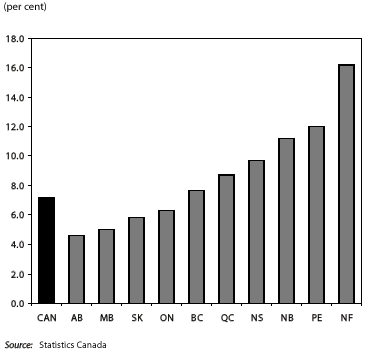
-
As a result of strong economic growth in 2001, the Alberta economy created 43,900 new jobs. Job gains were led by mining, construction, and professional, scientific and technical services.
-
As a result, Alberta’s unemployment rate dropped from an average of 5.0% in 2000 to 4.6% in 2001, the lowest among the provinces. It is Alberta’s lowest annual unemployment rate since 1981.
-
In January 2002, the Alberta economy created 11,200 jobs. The unemployment rate was 4.7%, the lowest in Canada.

job
growth continues
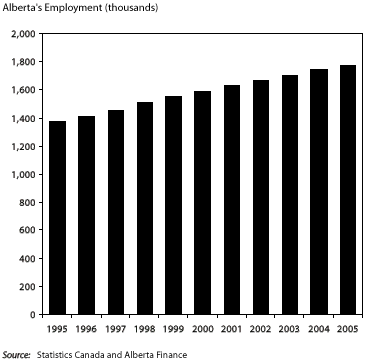
-
Although economic growth is expected to slow to 2.5% in 2002, the Alberta economy is forecast to create an additional 35,000 jobs this year. The unemployment rate, however, is expected to edge up to 5.1% as strong net interprovincial migration increases the labour force.
-
Over the medium term, employment growth is expected to average 2.2% per year. Approximately 144,000 additional jobs are expected between 2001 and 2005.
-
The unemployment rate is expected to gradually decline to 4.4% by 2005.

strong
wage gains

-
Healthy employment growth, and skill shortages in some key sectors boosted wages in Alberta. Led by gains in health care and construction, unionized wage settlements averaged 5.9% in 2001.
-
Overall, at 2.9%, Alberta had the highest increase in average weekly earnings among provinces in 2001. Wages are forecast to increase at an average rate of 3.2% per year over the forecast period, 1.3 percentage points higher than inflation.

highest
interprovincial migration
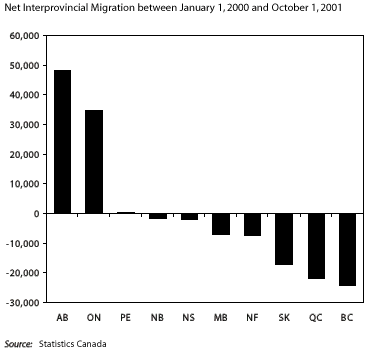
-
A strong labour market, healthy wage gains and low provincial tax rates have attracted a growing number of people to the province — 48,279 people have moved to Alberta since the beginning of 2000, more than any other province. Migrants have come mostly from British Columbia, Saskatchewan and Ontario.
-
Over the 2003-2005 period interprovincial migration is expected to add about 19,000 people to Alberta’s population per year.
-
Alberta's population reached 3.064 million in 2001 and is expected to grow by 1.7% per year on average through 2005, among the fastest in Canada.

alberta
leads retail sales in 2001
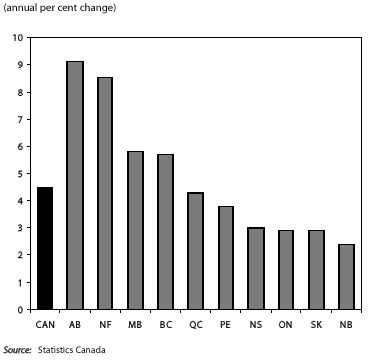
-
At 9.1%, Alberta led the country in retail sales growth in 2001, not surprising in view of its strong labour market, a 7.9% increase in wages and salaries, and a $1.1 billion provincial personal income tax cut.
-
Alberta also has the highest level of retail sales per capita.

real
consumer spending remains strong


strong
housing starts

-
Alberta's total housing starts reached 29,174 in 2001, up 11.1% from 2000. This is the highest level since 1981.
-
Over the medium term, housing starts in Alberta are expected to stabilize at around 27,000 per year due to strong interprovincial migration, low interest rates, and a healthy economy.

alberta
has highest nominal gdp per capita among provinces

-
Alberta had the highest nominal gross domestic product per capita among the provinces for 2000, the last year for which data are available.
-
In 2000, Alberta's GDP per capita was 29% higher than the next highest province, Ontario, and 38% higher than the average for Canada.

oil
price forecast benchmark
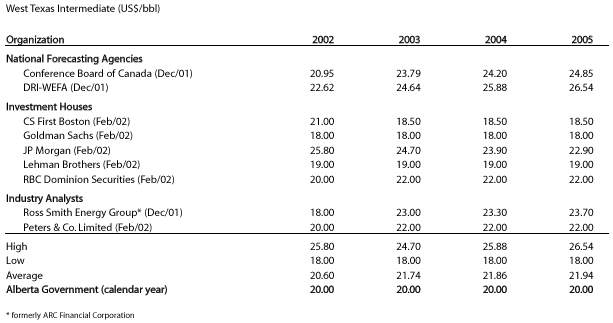

natural
gas price forecast benchmark


canadian
short-term interest rate forecast benchmark


CANADIAN
LONG-TERM INTEREST RATE FORECAST BENCHMARK


CANADA/UNITED
STATES EXCHANGE RATE FORECAST BENCHMARK
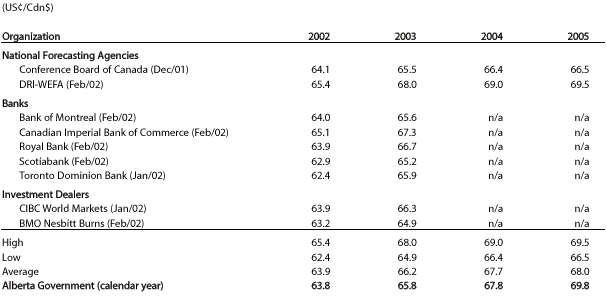

ALBERTA
REAL GROSS DOMESTIC PRODUCT FORECAST BENCHMARK
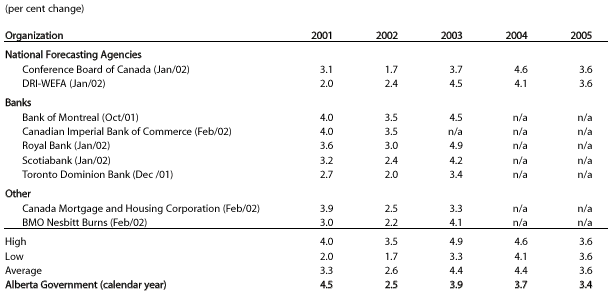

TRACKING
THE FORECASTS OF OIL PRICES


tracking
the forecasts of natural gas prices
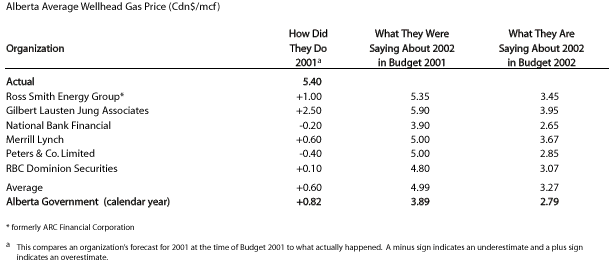

announced
major projects over $100 million
Proposed or Under Construction
|
Company Name |
Location |
Type
of Project |
Cost
($millions) |
Timing |
| OIL
AND GAS |
|
|
|
|
| Albian
Sands Energy Inc. |
RM
of Wood Buffalo (Muskeg River)
|
Oilsands
Mining/Extraction Plant |
2,200 |
1999-2002 |
| Canadian
Natural Resources |
MD
of Bonnyville (Cold Lake and Beartrap, Charlotte and Pelican Lakes) |
In
situ Bitumen Project |
800 |
1997-2002 |
| |
Lakeland County (Primrose/Wolf Lake) |
In
situ Bitumen Production Expansion - Stage
1 |
130 |
2001-2004 |
| Conoco
Canada Resources (formerly Gulf
Canada Resources)/ Fina Resources Inc. |
RM
of Wood Buffalo (Surmont) |
SAGD
Bitumen Commercial Project - Phase 2 and 3 |
500 |
2003-2010 |
| Imperial Oil |
Strathcona
County |
Srathcona
Refinery Upgrades |
500 |
2001-2005 |
| Imperial
Oil Resources |
MB
of Bonnyville (near Cold
Lake) |
Heavy
Oil Plant Expansion "Mahkeses" |
650 |
2001-2002 |
| Japan
Canada Oil Sands Co Ltd. (JACOS) |
RM
of Wood Buffalo (Hangingstone) |
SAGD
Bitumen Production - Phase 3 |
130 |
2001-2002 |
| Pan
Canadian Petroleum |
RM
of Wood Buffalo (Christina
Lake ) |
SAGD
Bitumen Production |
400 |
2000-2009 |
| Petro-Canada
Oil and Gas |
RM
of Wood Buffalo (MacKay
River) |
SAGD
Bitumen Production |
290 |
2001-2002 |
| |
Strathcona
County |
Strathcona
Refinery: Gasoline De-Sulphurization - Phase 1 |
130 |
2001-2003 |
| Petro-Canada
Oil and Gas/Nexen Inc. |
RM
of Wood Buffalo (S of Fort McMurray) |
"Meadow
Creek" SAGD Bitumen Production |
645 |
2005-2006 |
| Petrovera
Resources Ltd. |
Lindbergh/Elk
Point/Frog Lake/Marwayne |
In
situ Bitumen Projects |
1,200 |
2000-2010 |
| Ranger
Oil Ltd. |
MD
of Bonnyville (Lindbergh/Wolf
Lake/Elk Point/Cold Lake) |
In
situ Bitumen Production Expansion |
225 |
1996-2003 |
| Shell
Canada Ltd. |
Strathcona
County |
Scotford Refinery Modifications |
450 |
2000-2002 |
| Shell
Canada/Western Oil Sands/Chevron Canada Res. |
Strathcona
County |
Bitumen
Upgrader |
1,700 |
2000-2002 |
| Suncor Energy
Inc. |
RM
of Wood Buffalo (Fort
McMurray) |
Production
Enhancement |
127 |
1999-2002 |
| |
Lakeland
County (Primrose/Burnt
Lake) |
In
situ Bitumen Facilities - Phase 2 |
100 |
2001-2002 |
| |
RM
of Wood Buffalo |
"Firebag"
In situ Bitumen Recovery Project - Phase 1 |
1,000 |
2001-2005 |
| Syncrude
Canada Ltd. |
RM
of Wood Buffalo (Fort
McMurray) |
Continuous
Improvement Program |
1,500 |
1997-2007 |
| |
RM
of Wood Buffalo (Fort
McMurray) |
Phase
3: Upgrader Expansion Phase 1/Aurora Mine Train 2 |
4,100 |
2001-2004 |
| Union
Pacific Resources Group Inc. |
Cold
Lake / Provost / Lindbergh |
In
situ Bitumen Production |
400 |
2001-2003 |
| PIPELINES |
|
|
|
|
| Cold
Lake Pipleine Limited Partnership |
Foster
Creek to Bonnyville area to Hardisty
|
Expansion
of Cold Lake Pipeline System |
143
|
2002-2004 |
| Corridor
Pipeline Ltd. (Trans Mountain Pipeline) |
RM
of Wood Buffalo (Muskeg
River) to Strathcona County
|
"Corridor"
Bitumen Pipeline |
700 |
2000-2003 |
| Nova
Gas Transmission Ltd. |
across
Alberta |
Pipeline
Capacity Addition |
1,000 |
1999-2003 |
| MANUFACTURING |
|
|
|
|
| Shell Canada
Ltd. |
Strathcona
County |
Hydrogen
Manufacturing Plant for Scotford Upgrader |
180 |
2000-2002 |
| COMMERCIAL,
RETAIL and REAL ESTATE CONSTRUCTION |
|
|
|
|
| Cameron
Corporation/ Grosvenor International Canada
Ltd. |
Edmonton |
"South
Edmonton Common" Retail
Complex |
250 |
1997-2005 |
| East
Village Partnership Group |
Calgary |
Re-development
of East Village |
1,500 |
2001-2010 |
| Heartland
Development Corp. |
Airdrie |
Heartland
Business Centre |
500 |
2001-2010 |
| Shivam
Developments |
Strathcona
County (Sherwood Park) |
Auto
Mall and Shopping Centre |
150 |
2002-2006 |
| OTHER |
|
|
|
|
| Bell
Intrigna/Bell Nexxia/Axia Net Media & Partners |
Across Alberta
|
Fibre-optic
Communications Grid |
300 |
2001-2003 |
| Calgary
Airport Authority |
Calgary |
Airport
Improvements |
800 |
1998-2007 |
| Canadian
National Railways |
Edmonton
to Ontario |
Railway
Upgrade |
100 |
1997-2002 |
| Stone
Creek Properties |
Canmore |
Silver
Tip Hotel/Resort Village |
270 |
1995-2015 |
| Various
Irrigation Districts |
Across
Southern Alberta |
Irrigation
Systems / Rehabilitation |
600 |
1997-2006 |
| POWER
PLANTS* |
|
|
|
|
| AES
Calgary Inc. |
MD
of Rocky View (east of Calgary) |
Natural
gas fired Power Station (525 MW) |
450 |
2002-2004 |
| Atco
Power/Shell Canada Ltd. / Air Products Canada Ltd. |
Strathcona
County |
Co-generation
Facility (150 MW) |
140 |
2000-2002 |
| Calpine
Corp. |
Calgary |
Calgary
Energy Centre Gas-Fired Power Plant (250MW) |
220 |
2001-2003 |
| TransAlta
Utilities |
Parkland
County (Lake Wabamun) |
Expansion
of Keephills Coal-fired Generating
Plant (900 MW) |
1,600 |
2002-2005 |
| |
Parkland
County |
Efficiency
Update at Sundance Thermal Plant (218 MW) |
200 |
2001-2002 |
| TransCanada
Pipelines Ltd. / Petro-Canada |
RM
of Wood Buffalo (near Fort McMurray) |
MacKay
River Co-Gen Project (165MW) |
135 |
2001-2003 |
| TOTAL |
|
|
26,415 |
|

Go to: The
Alberta Advantage
|
